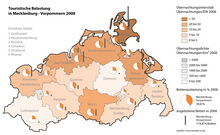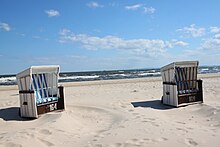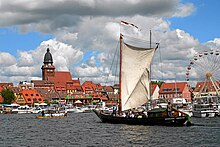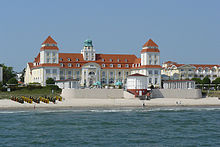Tourism in Mecklenburg-Western Pomerania

The tourism in Mecklenburg-Western Pomerania is one of the country's major industry. In addition to the landscape with extensive expanses of water, many nature reserves and three large national parks, the historic cities as well as the seaside resorts, health resorts and resorts are the main attractions of Mecklenburg-Western Pomerania. In addition, there are also offers for rural holidays and other special vacations, such as 2000 palaces, castles and manor houses. Mecklenburg-Western Pomerania is the only state in Germany that has posted double-digit growth rates in tourism since the turn of the millennium. This growth is attributed, among other things, to the continuous improvement of the tourist infrastructure and service quality, the catching up with the coasts of Schleswig-Holstein and Lower Saxony, the growing purchasing power in the eastern part of Germany and the increasing interest abroad. The country was the first time in 2014, the popular German domestic tourist destination Bavaria (measured in traveling from five days duration) across countries overall it reached in Hessen the 6th Place . Mecklenburg-Western Pomerania held this position in 2015 as well.
Tourism fairs
The travel destination Mecklenburg-Western Pomerania presents itself annually with its own stand at the world's leading trade fair for tourism, the International Tourism Exchange Berlin (ITB). The 52nd ITB from March 7th to 11th 2018 has a German partner country for the first time in Mecklenburg-Western Pomerania.
statistics
Mecklenburg-Western Pomerania is the most popular travel destination for domestic travel and also has the strongest growth in foreign guests. Out of 100 German travelers to Germany and abroad, 8 chose Mecklenburg-Western Pomerania as their destination, which corresponds to around 25% of all domestic German trips of at least 5 days. The tourism industry in the country achieved sales of around 5.1 billion euros in 2016. In 2009, around 195,000 guest beds were available in Mecklenburg-Western Pomerania - compared to 60,000 beds in 1992. In 2013 there were 7,081,000 (6,993,000 in 2012) guests with 28,157,000 (27,940,000 in 2012) Overnight stays, of which 965,000 were guests from abroad. There were 175 campsites, 202 museums and 116 movie theaters in 2006.
The number of guests and overnight stays are very different within the country. In 2007, the then Ostvorpommern ( Usedom ) district came to 800,000 guests and the Rügen district (islands of Rügen and Hiddensee) over a million guests. In the Mecklenburg Lake District ( the district Mecklenburg-Strelitz , Müritz district , Neubrandenburg ) stayed more than 500,000 guests. In 2007, 181,000 and 552,000 guests stayed in the cities of Schwerin and Rostock . In contrast, the rural areas such as the former Ludwigslust district and Demmin district came to less than 100,000 guests per year. They also stayed on site for a shorter period on average (less than 3 nights per guest).
Landscapes
The higher-ranking landscapes are West Mecklenburg , Central Mecklenburg , Western Pomerania and the Uckermark .
In addition to the islands and peninsulas on the Baltic Sea, Poel , Fischland-Darß-Zingst , Hiddensee , Rügen , Usedom and the Bodden landscape (which includes the Darß-Zingster Bodden chain and the Greifswalder Bodden ), there are the lake landscapes in the hinterland. These include the Mecklenburg Lake District , the Feldberg Lake District and the Sternberg Lake District . Here you will also find the largest lakes such as the Müritz and Schweriner See . Other landscapes in the hinterland are the Griese area , Lewitz and Mecklenburg Switzerland .
Baltic coast
Many of the country's attractions are mainly on the Baltic Sea . Several traditional seaside resorts are located on it, such as Boltenhagen , Graal-Müritz , Heiligendamm (the oldest seaside resort in Germany), Kühlungsborn , Warnemünde , Rerik , Lubmin and the places of Fischland-Darß-Zingst . Furthermore, the seaside resorts on the islands of Hiddensee , Rügen ( Baabe , Binz , Göhren , Sellin , Sassnitz ) and Usedom ( Zinnowitz , amber baths , Heringsdorf municipality with the imperial baths) are of great importance.
In addition, there are the Hanseatic cities with cultural and historical significance such as Greifswald , Rostock , Stralsund , Wismar and Wolgast . During the times of the GDR , the Baltic Sea coast served as the main destination for mass tourism organized by the FDGB .
Mecklenburg Lake District & Mecklenburg Switzerland
In the hinterland, the former residential cities of Güstrow , Ludwigslust , Neustrelitz and the state capital Schwerin stand out. The hinterland of Mecklenburg-Western Pomerania is flat and undulating and rich in lakes. In the Mecklenburg Lake District , in Mecklenburg Switzerland and in the Feldberg Lake District there is an increasing number of tourist infrastructure. The main focus of tourism here is Waren (Müritz) , Plau am See and Fleesensee . But even in the smallest villages there are original country inns or hotels and restaurants in many castles. There are also numerous offers for water sports enthusiasts (sailing, fishing, canoeing, water skiing, etc.) and a well-developed infrastructure for cyclists.
Nature reserves
One of the last official acts of the GDR government was the designation of extensive nature reserves along the coast (e.g. Vorpommersche Boddenlandschaft National Park ) and in the hinterland ( Müritz National Park ). Here you will find a rich fauna (e.g. breeding grounds for rare birds) and an intact nature. Cycle tourism, water sports and camping are possible with restrictions.
In Mecklenburg-Vorpommern there are three national parks ( Jasmund , Müritz and Vorpommersche Boddenlandschaft ), furthermore seven nature parks ( Am Stettiner Haff , Feldberger Seenlandschaft , Peenetal river landscape , Usedom island , Mecklenburg Switzerland and Kummerower See , Nossentiner / Schwinzer Heide and Sternberger Seenland ), three biosphere reserves ( river landscape Elbe-Mecklenburg-Western Pomerania , Schaalsee and southeast Rügen ) and four wetlands (West Rügen-Hiddensee-Zingst, east bank Müritz, Galenbecker See and Krakower Obersee). In addition, a plurality of protected areas , such as the Peenemünder hook, Struck and Ruden , the nature reserve Nonnenhof , the fish ponds in the Lewitz and Peenetal -Moor.
Cities
Many cities in Mecklenburg-Western Pomerania are worth seeing and have historic city centers. In addition to the two city centers Wismar and Stralsund, which have been recognized as UNESCO World Heritage Sites , a. Bad Doberan , Boizenburg , Greifswald , Grabow , Güstrow , Krakow am See , Ludwigslust , Neubrandenburg , Neustadt-Glewe , Neustrelitz , Parchim , Putbus , Röbel , Rostock (with the Baltic Sea resort of Warnemünde ), Schwerin , Ueckermünde , Waren (Müritz) and Wolgast deserve special mention .
Castles and manor houses
Further architectural monuments
- Category: Monument in Mecklenburg-Western Pomerania
- List of churches in Mecklenburg-Western Pomerania
- List of windmills in Mecklenburg-Western Pomerania
Museums
- Old Penzlin Castle
- Groß Raden archaeological open-air museum
- German Amber Museum in Ribnitz-Damgarten
- German Maritime Museum in Stralsund
- Schwerin-Mueß open-air museum
- Fritz Reuter Literature Museum in Stavenhagen
- Gorch Fock (ship, 1933) in Stralsund
- Historical-Technical Museum Peenemünde
- HMS Otus (S18) in Sassnitz
- Granitz Hunting Lodge
- Holy Cross Monastery (Rostock)
- Stralsund Cultural History Museum
- Rostock art gallery
- Ahrenshoop Art Museum
- Müritzeum in goods
- Nautineum Stralsund
- Otto Lilienthal Museum in Anklam
- Ozeaneum Stralsund
- Pommersches Landesmuseum in Greifswald
- Regional Museum Neubrandenburg
- State Museum Schwerin
- City history museum of the Hanseatic city of Wismar
- Technical State Museum in Schwerin
- Traditional ship type Frieden in Rostock
- Ukranenland in Torgelow
Recreational facilities
- Rostock ice rink
- Ruegen Park
- alpincenter Hamburg-Wittenburg (year-round winter sports hall)
- Karl's adventure village in Rövershagen , Zirkow and Koserow
Leisure pools
Large swimming pools and thermal baths (mostly with a sauna ) are:
- Ahlbeck on Usedom: Ostseetherme
- Binz on Rügen: Binz thermal baths
- Greifswald : Greifswald leisure pool
- Güstrow : Oasis leisure pool
- Göhren-Lebbin : Land Fleesensee Spa
- Graal-Müritz : Aquadrom
- Kühlungsborn : Kübomare
- Linstow : Van der Valk-Resort Linstow
- Ribnitz-Damgarten : Bodden thermal baths
- Röbel / Müritz : MüritzTherme
- Sagard on Rügen: Jasmund Therme & Spa
- Sellin on Rügen: Inselparadies adventure pool
- Stralsund : HanseDom
- Warnemünde : a-yes Warnemünde seaside resort
- Wismar : Wonnemar Wismar
- Zinnowitz on Usedom: Bernsteintherme
Zoos, zoos and botany

- Parks in Mecklenburg-Western Pomerania
- Bansin Tropical Zoo ( Usedom )
- Tiger Park Dassow
- Ivenack oaks
- Wildlife Park MV
- Marlow Bird Park
- Bear Forest Müritz
- Neustrelitz Zoo
- Rostock Zoo
- Rügen dinosaur land
- Sassnitz animal park
- Schwerin Zoo
- Stralsund Zoo
- Ueckermünde Zoo
- Wismar animal park
- Wolgast Zoo
Events
- Sweden Festival in Wismar
- Mecklenburg-Western Pomerania Festival
- Pirate Open Air in Grevesmühlen
- Müritz saga in goods
- Hanse Sail in Rostock
- Wismar harbor days
- Müritz Sail
- Störtebeker Festival
- Usedom Music Festival
- Wallenstein Days in Stralsund
- Warnemünde Week
- Midsummer vacation - cultural heritage festival of manor houses
Accommodation and gastronomy
overnight stay
Mecklenburg-Western Pomerania has a very good infrastructure of hotels , holiday homes, guest houses and youth hostels . The choice and amount of overnight accommodation has increased significantly since 1990. All overnight accommodations near the Baltic Sea or on the large Mecklenburg lakes are naturally particularly popular. Private accommodation in the country and holidays on the farm are also offered.
There are also a large number of holiday homes and campsites . The number of holiday homes and guest houses in particular has risen sharply since 1990. There are many water rest areas at the larger lakes and rivers where you can also spend the night.
For bicycle tourists there are the ADFC- certified bed + bike restaurants on the long-distance cycle paths (see By bike ) .
With 27 youth hostels, a youth campsite, around 440,000 overnight stays per year and around 200 employees, the DJH regional association is the largest youth tourism provider in Mecklenburg-Western Pomerania.
eat
The Mecklenburg-West Pomeranian cuisine is generally considered to be down-to-earth and hearty. It reflects on the one hand the long-term poverty of the regions of Mecklenburg and Western Pomerania , as well as the abundance of fish in the Baltic Sea and inland waters. There is also an abundance of game dishes . Potatoes (also sometimes called tüften here ) play a particularly important role in a wide variety of preparation methods , kale and also the sweet and sour taste, produced for example by baked fruit . All of these points indicate that the cuisine in Mecklenburg-Western Pomerania is typical of north-east Germany .
Local specialties are salted herring, herring in cream sauce, heaven and earth , potato soup with plums and bacon, Pomeranian Tollatschen , pears, beans and bacon , honey cake on the tray, small Pomeranian cakes, Pomeranian honey butter cakes, Pomeranian quarkbollers, white pepper nuts, Pomeranian yeast pods Dumplings, black and sour, herringbone rolls, etc. v. a.
Barrier-free tourism
With the expansion of the tourist infrastructure in Mecklenburg-Western Pomerania, offers are being created and expanded in some places that can also be used by people with reduced mobility, such as the Plau am See youth hostel , the ZERUM Ueckermünde with the Ueckermünde roller-coaster coat of arms , the Ozeaneum Stralsund , the Natural Heritage Center Rügen . In May 2014 the first barrier-free beach on Rügen was opened in Altefähr .
Transport links
automobile

The federal highway 20 runs through the country from east to west . It runs in the hinterland of the Baltic Sea coast and connects the east of Mecklenburg-Western Pomerania with the west. The motorway runs continuously from the Uckermark junction on the A 11 shortly before Stettin via the immediate hinterland of the Baltic Sea coast of Mecklenburg-Western Pomerania to Lübeck to the federal motorway 1 .
The federal motorway 24 leads from Berlin in the direction of Hamburg. It crosses the A 14 to Wismar near Schwerin . This should lead from Saxony via Saxony-Anhalt and Brandenburg to Wismar. The piece south of the federal highway 24 to Magdeburg is currently missing. At Wittstock / Dosse the federal highway 19 branches off from the federal highway 24 in the direction of Rostock. Here it crosses the Mecklenburg Lake District and crosses the A 20 near Rostock and ends shortly afterwards at Rostock harbor.
An alternative to arriving via the autobahn are federal highways, some of which lead to Mecklenburg-Western Pomerania as holiday routes or follow historical trade routes. The most important of these are the B 96 , B 103 , B 104 and B 191 .
train
The main railway line Berlin – Hamburg runs through the southwestern periphery of Mecklenburg-Western Pomerania . There are also connections from this route in the direction of Schwerin-Bad Kleinen-Wismar from Ludwigslust and from Hagenow, as well as a branch to Rostock with a connection to Stralsund and the island of Rügen . Other main lines are the connections Berlin – Neustrelitz – Stralsund and their branch line Neustrelitz – Rostock , Berlin – Angermünde – Stralsund and the east-west connection with the Bützow – Szczecin railway line . There are also various branch lines and the Bäderbahnen, such as the Ahlbeck – Wolgast line of the Usedomer Bäderbahn on the Baltic Sea coast. There are also two narrow-gauge railways , which are very interesting for tourists, with the Rasenden Roland on Rügen and the Molli near Bad Doberan .
plane
Rostock-Laage Airport is by far the largest and busiest airport in Mecklenburg-Western Pomerania . Several medium-sized regional airports, where aircraft up to the size of the Airbus A320 can land, are located in Trollenhagen near Neubrandenburg , in Heringsdorf on Usedom , in Parchim near Schwerin and in Barth near Stralsund . They were created from former air force bases of the NVA and the air forces of the Soviet Union . There are also numerous smaller airfields, for example in Güttin on Rügen, Rechlin-Lärz, Peenemünde on Usedom, Rerik, Pasewalk or Neustadt-Glewe.
Ship or boat

Due to its location on the Baltic Sea, Mecklenburg-Western Pomerania can be easily reached by ship or boat. Important ports are the ports of Rostock , Stralsund , Wismar and the ferry port of Sassnitz . The ports in Wolgast and Greifswald are only of regional significance for merchant shipping. In addition to these harbors, there are also a large number of smaller harbors, which are mostly developed as resting places for water hikers and marinas . Car and train ferries run regularly from Rostock and Sassnitz to Trelleborg , Gedser and Klaipėda .
Rostock's Warnemünde district is the largest cruise port in Germany with over 800,000 passenger movements per year.
The sport boat skipper finds sufficient activity in the Baltic Sea and in the Bodden , but also on the larger inland lakes. The inland lakes can be reached via the Havel or Elbe . The Hanse Sail in Warnemünde should be mentioned as an outstanding event . The Müritz Sail in Waren has established itself as an inland offshoot of this event . In addition to sailing and motor boating, hiking in the inland waters by canoe or kayak plays an important role. Significant areas are here Mecklenburg Lake District , the Sternberg Lake District , the Schwerin Lake and the Warnow and the Peene and its tributaries and the Barthe .
bicycle
Cycling tours and day trips by bike have become a tourist focus in Mecklenburg-Western Pomerania. The country regularly takes a top spot in the ADFC's annual assessment of the popularity of long-distance cycle routes . Seven designated routes lead through the country, two of which, the Baltic Sea Cycle Route and the Berlin – Copenhagen cycle route, are part of the European EuroVelo cycle path project .
- Baltic Sea Cycle Route - 650 km from Travemünde to Ahlbeck (Heringsdorf) via Wismar , Kühlungsborn , Warnemünde , Ahrenshoop , Barth , Stralsund , Gingst , Kap Arkona , Sassnitz , Sellin , Putbus , Stralsund, Greifswald , Wolgast
- Berlin – Copenhagen cycle route - 255 km from Fürstenberg to Rostock via Neustrelitz , Waren (Müritz) , Krakow am See , Bützow
- Long-distance cycle route Hamburg – Rügen - 388 km from Ratzeburg to Sassnitz via Schwerin , Warin , Güstrow , Teterow , Demmin , Stralsund , Putbus
- Mecklenburg Lake Cycle Path - 625 km from Lüneburg to Wolgast via Amt Neuhaus , Dömitz , Ludwigslust , Parchim , Plau , Röbel , Waren (Müritz) , Mirow , Neustrelitz , Neubrandenburg , Ueckermünde , Anklam , Ahlbeck (Heringsdorf)
- Oder-Neisse cycle path - 80 km from Penkun via Löcknitz to Ueckermünde
- Elbe Cycle Path - 72 km from Dömitz to Boizenburg
- Long distance cycle route Berlin – Usedom - 157 km from Pasewalk to Peenemünde via Ueckermünde , Anklam , Ahlbeck (Heringsdorf)
Most of the routes are signposted with signposts and special route symbols.
The Mecklenburg-Western Pomerania Tourism Association offers 21 circular bike tours with the thematic routes Western and Eastern Brick Walk, Manor House Circuit, Manor House Circuit, Residence Town Circuit and Castle Circuit, as well as the Fischland - Darß - Zingst , Rügen , Usedom landscape routes , Peenetal , Stettiner Haff , Ice Age Route, Trebeltal , Brohmer Berge and Randowtal , Tollensetal , Müritz , Eldetal , Elbetal - Schaalsee , Warnowtal , Mecklenburg Lake District and Recknitztal .
For bicycle tourists, there are numerous other overnight accommodation options, as well as the Bed + Bike restaurants that are specially designed for overnight stays .
Tourism award
In 2010 the “Mecklenburg-Western Pomerania Tourism Prize” was awarded for the first time by the Mecklenburg-Western Pomerania Tourism Association and donated by Deutsche Kreditbank AG . The first winners of the annual honor since then have been the former chairman of the German Foundation for Monument Protection Gottfried Kiesow and the Aktiongemeinschaft Freier Himmel eV ( Wittstock military training area ). In addition, the badge of honor is awarded annually for special services to tourism in Mecklenburg-Western Pomerania.
Further award winners:
- 2011: Michael Succow (Nature Conservation, " National Natural Landscapes ")
- 2012: Matthias von Hülsen ( Mecklenburg-Western Pomerania Festival ) & Dr. Wolfgang Bordel ( Vorpommersche Landesbühne )
- 2013: Jost Reinhold (around 1000 charitable projects, such as sponsoring the Müritzeum and the youth center in Waren / Müritz)
- 2014: Horst Rahe ( German shipping company )
- 2015: German Society for the Rescue of Shipwrecked People
- 2016: Störtebeker Festival on Rügen
- 2017: Jürgen Seidel , long-time chairman and president of the regional tourism association, since 1994 minister of construction and economy, 2006–2011 regional minister for tourism
See also
- List of seaside resorts, health resorts and recreational areas in Mecklenburg-Western Pomerania
- Nature conservation in Mecklenburg-Western Pomerania
Web links
- Statistical data on tourism in MV (Statistical Office)
- Mecklenburg-Western Pomerania Tourist Association
Individual evidence
- ↑ a b tourism portal on the state website of Mecklenburg-Western Pomerania , accessed on March 10, 2017
- ↑ Record overnight stays in Mecklenburg-Western Pomerania - 30.3 million overnight stays in 2016
- ^ Maximilian Weingartner: Rügen instead of Tuscany. Mecklenburg-Western Pomerania has developed into a tourist magnet . In: Frankfurter Allgemeine Zeitung, September 29, 2015, p. 20.
- ^ Foundation for Future Issues - an initiative by British American Tobacco : 32nd German Tourism Analysis , Research News, 267, vol. 37, February 17, 2016.
- ^ ITB: Stage for Mecklenburg-Western Pomerania , Deutsche Welle , March 5, 2018
- ↑ MV is the most popular travel destination in Germany , NDR , March 4, 2015
- ↑ http://www.statistik-mv.de/cms2/STAM_prod/STAM/de/htd/Veroeffnahmungen/index.jsp?para=e-BiboInterTh07&linkid=070301&head=0703
- ↑ Selection of leisure pools at auf-nach-mv.de , accessed on September 24, 2014
- ↑ Accessible offers , accessed on October 6, 2014
- ↑ Long-distance cycle routes - seven varied adventure tours , Tourismusverband MV e. V.
- ↑ Round bike tours - 21 wonderful trips for your short vacation , Tourismusverband MV e. V.
- ↑ "Without the Bombodrom, but with Mr. Backstein: First Mecklenburg-Western Pomerania Tourism Awards awarded" , message from the Press Center of TV Mecklenburg-Western Pomerania, accessed January 3, 2011, 6:30 pm
- ↑ Mecklenburg-Western Pomerania Tourism Prize
- ↑ Prize Winner Tourism Prize 2017 - Jürgen Seidel , accessed on March 8, 2018














